
Anton Mauve was an early influence on van Gogh, working with him for a short time. This prolific and popular Dutch realist painter's wife was van Gogh's cousin.
Anton Mauve (Dutch, 1838-1888), Changing Pasture, c. 1880s, oil on canvas, 24 x 39 5/8 inches (61 x 100.6 cm), Metropolitan Museum of Art, NY.

Anton Mauve, Entering the Fold, c. 1885-8, drawing and watercolor on paper,
505 x 60.3 cm, Tate Gallery, London. See pastoral.
Examples of his work:
Vincent van Gogh, Flower Beds in Holland, April 1883 ([place made:] The Hague), 48.9 x 66 cm, oil on canvas, National Gallery of Art, Washington, DC, F [De la Faille catalogue raisonné number] 186. From 1881 to 1885 van Gogh lived in the Netherlands, sometimes in lodgings, supported by his devoted brother Theo, who regularly sent him money from his own small salary.

Vincent van Gogh, Thatched Roofs, 1884, pen
and ink, pencil
and gouache on
paper, 30.5 x 44.8 cm, Tate Gallery,
London.

Vincent van Gogh, Peasant Woman Cooking by a Fireplace,
1885, oil on canvas,
17 3/8 x 15 inches (44.1 x 38.1 cm), Metropolitan Museum of Art,
NY.
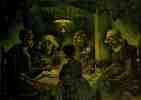
Vincent van Gogh, The
Potato Eaters, September-October 1885 (Nuenen), oil
on canvas, 32 1/4 x 45
inches (81.5 x 114.5 cm), Rijksmuseum Vincent van Gogh, Amsterdam,
F 82. Of this van Gogh wrote to Theo: "I have tried to emphasize
that those people, eating their potatoes in the lamp-light have
dug the earth with those very hands they put in the dish, and
so it speaks of manual labor, and how they have honestly earned
their food."
Vincent van Gogh, Skull with Burning Cigarette, winter 1886/1887 (Antwerp), oil on canvas, 32.5 x 24 cm, Rijksmuseum Vincent van Gogh, Amsterdam, F 212. In 1885 van Gogh moved to Antwerp on the advice of Antoine Mauve (a cousin by marriage), and studied for some months at the Academy there. Academic instruction had little to offer such an individualist, however, and in February 1886 he moved to Paris, where he met Pissarro, Degas, Gauguin, Seurat, and Toulouse-Lautrec. His painting underwent a violent metamorphosis under the combined influence of Impressionism and Japanese woodcuts, losing its moralistic flavor of social realism. See vanitas.

Vincent van Gogh, Self-Portrait with a Straw Hat; (verso)
The Potato Peeler, oil
on canvas, 16 x 12 1/2
inches (40.6 x 31.8 cm), Metropolitan Museum of Art, NY. See
self-portrait.

Vincent van Gogh, Montmartre
Near the Upper Mill, winter 1886-1887 (Paris), oil
on canvas, 17 1/4 x 13
1/4 inches (44 x 33.5 cm), Art Institute of Chicago, F 272. Van
Gogh moved to Paris, where, living with Theo, he was greatly
influenced by the bright colors used by the Impressionists. He
became obsessed by the symbolic
and expressive values
of colors, using them more for this purpose than, as the Impressionists
did, for the reproduction of visual appearances, atmosphere,
and light. "Instead of trying to reproduce exactly what
I have before my eyes," he wrote, "I use color more
arbitrarily so as to express myself more forcibly."

Vincent van Gogh, Sunflowers, 1887, oil
on canvas, 17 x 24 inches
(43.2 x 61 cm), Metropolitan Museum of Art, NY. See still life.

Vincent van Gogh, Self-Portrait
in Front of the Easel, winter 1887-1888 (Paris), oil on canvas,
25 5/8 x 20 1/8 inches (65 x 50.5 cm), Rijksmuseum Vincent van
Gogh, Amsterdam, F 522.
Vincent van Gogh, Orchard with Blossoming Plum Trees, also called "The White Orchard," April 1888 (Arles), oil on canvas, 60 x 80 cm, Rijksmuseum Vincent van Gogh, Amsterdam, F 403. In February of 1888, the craving for sunlight and warmth drove van Gogh south to Arles. There he painted more than 200 canvases in 15 months.

Vincent van Gogh, The Flowering Orchard, 1888, oil
on canvas, 28 1/2 x 21
inches (72.4 x 53.3 cm), Metropolitan Museum of Art, NY.

Vincent van Gogh, Vase
with Twelve Sunflowers, August 1888 (Arles), oil
on canvas, 35 7/8 x 28
inches (91 x 71 cm), Bayerische Statsgemäldesammlungen,
F 456.
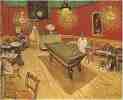
Vincent van Gogh, The
Night Café, September 1888 (Arles), oil
on canvas, 27 1/2 x 39
inches (70 x 89 cm), Yale University Art Gallery, F 463. Of his
Night Café, van Gogh said: "I have tried to
express with red and green the terrible passions of human nature."
The establishment depicted
here is currently known as Café de l'Alcazar, on the Place
Lamartine.
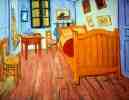
Vincent van Gogh, Vincent's
Room, October 1888 (Arles), oil
on canvas, 28 1/4 x 38
1/2 inches (72 x 90 cm), Vincent Van Gogh Foundation, Amsterdam,
F 482.

Vincent van Gogh, Shoes, c. 1888, oil
on canvas, 17 3/8 x 20
7/8 inches (44.1 x 53 cm), Metropolitan Museum of Art, NY.

Vincent van Gogh, Portrait of Joseph Roulin, 1888, reed
quill pens and brown ink and black chalk, 12 5/8 x 9 5/8 inches (32 x 24.4 cm),
J. Paul Getty Museum, Malibu, CA.
Vincent van Gogh, Pollard Willows With Setting Sun, autumn 1888 (Arles), oil on canvas, 31.5 x 34.5 cm, Kroller-Müller Museum, Otterlo, F 572.

Vincent van Gogh, Memory of the Garden at Etten (Ladies of Arles),
November 1888, oil on canvas, 29 x 36 1/2 inches
(73 x 92 cm), Hermitage Museum, St. Petersburg, Russia.

Vincent van Gogh, Self-Portrait
with Bandaged Ear, January 1889 (Arles), oil
on canvas, 23 1/2 x 19
1/4 inches (60 x 49 cm), Courtauld Institute Galleries, London,
F 527. Note the print
by Sato Torakiyo (Japanese). In Arles, van Gogh was in poverty,
and suffered recurrent nervous crisis with hallucinations and
depression. He became enthusiastic for the idea of founding an
artists' co-operative at Arles, and towards the end of 1888,
he was joined by Gauguin. But as a result of a quarrel between
them van Gogh suffered the crisis in which occured the famous
incident when he cut off his left ear (or part of it), an event
commemorated in his Self-Portrait
with Bandaged Ear.

Vincent van Gogh, A Corner of the Garden of St. Paul's Hospital
at St. Rémy, 1889, pencil
and pen and ink
on paper, 62.2 x 48.3 cm, Tate Gallery,
London.

Vincent van Gogh, Irises, May 1889 (Saint-Rémy), oil on canvas,
28 x 36 3/4 inches (71 x 93 cm), Getty Museum, CA, F 608. In
May 1889 van Gogh went at his own request into an asylum at Saint-Rémy,
near Arles, but continued during the year he spent there a frenzied
production of tumultuous pictures. He did 150 paintings besides
drawings in the course of this year.

Vincent van Gogh, A Corridor in the Asylum, late May or
June, 1889, black chalk
and gouache on
pink Ingres paper, 25 5/8 x 19 5/16
inches (65.1 x 49.1 cm), Metropolitan Museum of Art, NY. See
linear perspective.

Vincent van Gogh, La Berceuse (Woman Rocking a Cradle) (Augustine-Alix
Pellicot Roulin, 1851-1930), 1889, oil
on canvas, 36 1/2 x 29
inches (92.7 x 73.7 cm), Metropolitan Museum of Art, NY.
Vincent van Gogh, Landscape at Saint-Rémy, June 1889 (Saint-Rémy), 28 x 35 inches (70.5 x 88.5 cm), oil on canvas, Ny Carlsberg Glypotek, Copenhagen, F 611. This is a view from van Gogh's bedroom at Saint Paul's Hospital.
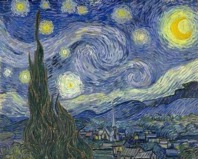
Vincent van Gogh (Dutch, 1853-1890), The Starry Night, June 1889 (Saint Rémy),
oil on canvas,
29 x 36 1/4 inches (72 x 92 cm), Museum of Modern Art, New York,
F 612. See expression
and nocturne.

Vincent van Gogh, Cypresses, June 1889 (Saint-Rémy),
oil on canvas,
36 3/4 x 29 1/8 inches (93.3 x 74 cm), Metropolitan Museum of
Art, New York, F 613.

Vincent van Gogh, Wheat Field with Cypresses, 1889, oil on canvas,
28 3/4 x 36 3/4 inches (73 x 93.4 cm), Metropolitan Museum of
Art, NY.

Vincent van Gogh, Self-Portrait,
September 1889 (Saint-Rémy), oil
on canvas, 25 1/2 x 21
1/4 inches (65 x 54 cm), Musée d'Orsay, Paris, F 627.

Vincent van Gogh, Olive Trees, November 1889 (Saint-Rémy), oil on canvas,
29 x 36 1/2 inches (74 x 93 cm), Minneapolis Institute of Arts,
F 710.

Vincent van Gogh, Women Picking Olives, 1889-90, oil
on canvas, 28 5/8 x 36
inches (72.7 x 91.4 cm), Metropolitan Museum of Art, NY.

Vincent van Gogh, Olive Orchard, oil
on canvas, 28 5/8 x 36
1/4 inches (72.7 x 92.1 cm), Metropolitan Museum of Art, NY.
This painting was exhibited in the influential Armory
Show of 1913.

Vincent van Gogh, L'Arlésienne: Madame Joseph-Michel Ginoux
(Marie Julien, 1848-1911), possibly 1889, oil
on canvas, 36 x 29 inches
(91.4 x 73.7 cm), Metropolitan Museum of Art, NY.

Vincent van Gogh, First Steps, after Millet, 1890, oil on canvas,
28 1/2 x 35 7/8 inches (72.4 x 91.1 cm), Metropolitan Museum
of Art, NY.
Vincent van Gogh, Old Vineyard with Peasant Woman, end of May 1890 (Auvers-sur-Oise), pencil, brush, watercolor, and gouache on paper, 17 1/4 x 21 1/4 inches (43.5 x 54 cm), Rijksmuseum Vincent van Gogh, Amsterdam, F 1624. In 1889 Theo married, and in May 1890 van Gogh moved to Auvers-sur-Oise to be near him, lodging with the patron and connoisseur Dr. Paul Gachet. There followed another tremendous burst of strenuous activity and during the last 70 days of his life he painted 70 canvases. But his spiritual anguish and depression became more acute and on July 29, 1890 he died from the results of a self-inflicted bullet wound.

Vincent van Gogh, Irises, c. 1890, oil
on canvas, 29 x 36 1/4
inches (73.7 x 92.1 cm), Metropolitan Museum of Art, NY.

Vincent van Gogh, Farms near Auvers, 1890, oil
on canvas, 50.2 x 100.3
cm, Tate Gallery, London.

Vincent van Gogh, Road
with Cypress and Star, May 1890 (Auvers-sur-Oise), oil on canvas,
36 1/4 x 28 3/4 inches (92 x 73 cm), Rijksmuseum Kroller-Muller,
Otterlo, F 683.

Vincent van Gogh, Portrait
of Dr Paul Gachet (1828-1909), June 1890 (Auvers-sur-Oise),
oil on canvas,
26 x 22 1/2 inches (66 x 57 cm), private collection, NY, F 753.
Dr. Gachet was a physician who specialized in homeopathy and
psychiatry. He was a consistently helpful and generous patron
and friend to numerous artists. On the recommendation of Pissarro,
Gachet took van Gogh into his house in 1890. A book about the
history of this painting -- from its creation to the 1990s --
is in print. See bad-debt art.

Vincent van Gogh, The Oise at Auvers, 1890, pencil
and gouache on
paper, 47.3 x 62.9 cm, Tate Gallery,
London.
Vincent van Gogh, Village Street in Auvers, June or July 1890, oil on canvas, 28 3/4 x 36 1/4 inches (73 x 92 cm), Ateneumin Taidemuseo, Helsinki, F 802.
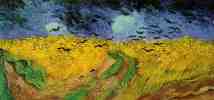
Vincent van Gogh, Wheat
Field Under Threatening Skies, July 1890 (Auvers-sur-Oise),
oil on canvas,
50.5 x 100.5 cm, Vincent van Gogh Museum, Amsterdam, F 779.
A joke:
"Vincent van Gogh had a larger family
than many people realize. Some of the lesser known members of
that family:
The grandfather who moved to Yugoslavia - U. Gogh
The brother who accidentally bleached all his clothes white -
Hue Gogh
The sister who wore a mini-skirt and liked to dance in bars -
Go Gogh
The really obnoxious brother - Please Gogh
The brother who ate prunes - Gotta Gogh
The uncle who was constipated - Cant Gogh
The uncle who worked at a convenience store - Stop N. Gogh
His dizzy aunt - Verti Gogh
The cousin who moved to Illinois - Chica Gogh
His magician uncle - Wherediddy Gogh
The cousin who lived in Mexico - Amee Gogh
Another cousin who lived in Mexico - Grin Gogh
Nephew who drove a stagecoach - Well Far Gogh
Aunt who loved Argentine dancing - Tan Gogh
His ornithologist uncle - Flamin Gogh
![]()
His nephew, the Freudian psychoanalyst- E. Gogh
His cousin who loved tropical fruits - Mang Gogh
The aunt who promoted positive thinking - Way to Gogh
His bouncy young nephew - Po Gogh
The niece, who's been traveling the US in a van - Winnie Bay
Gogh"
Credited by B. Moriarty to Nancy Sojka of Decorah, IA, on ArtsEdNet
Talk listserve, Jan. 27, 1998.
Also see ArtPage pages about other Post-Impressionists:
https://inform.quest/_art